Repairing Old Damaged Glass
by
Bob Brooke
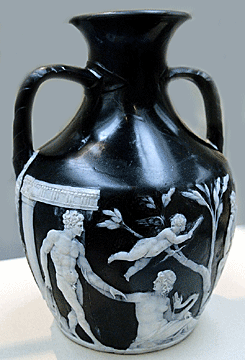 Glass
is fragile and prone to breakage, so it seems logical that itís less
possible to repair. A piece is either in prime condition or itís
damaged. And while repair is difficult, itís not impossible. Glass
is fragile and prone to breakage, so it seems logical that itís less
possible to repair. A piece is either in prime condition or itís
damaged. And while repair is difficult, itís not impossible.
Thereís one example of a piece broken into a thousand fragments being
skillfully repaired. On February 7, 1845, William Lloyd, after going on
a drinking binge, smashed the Portland Vase, a fine example of ancient
cameo glass. Restorers did such a fine job of reassembling and mending
it that scarcely a trace of the breakage is visible today. This was, of
course, a priceless piece, and the need of preserving an example of what
had long been a lost art was great enough to warrant the corresponding
expense.
Granted that few, if any, collectors have much chance of owning a
Portland Vase. Sometimes itís advisable to let a piece of broken glass
remain that way or discard itóa few minor defects in an otherwise fine
piece of glass can be minimized. To accomplish this requires skill and a
wide variety of glass working tools. Such repairs arenít for the
amateur, but must be done by a professional restoration expert with a
properly equipped shop. What a
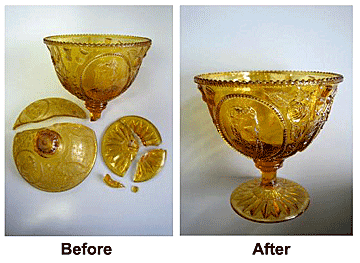 good
glass repairer can accomplish in eradicating blemishes caused by time
and use is incredible. With grinding and polishing wheels, a skilled
restorer can remove all traces of nicks and chips. good
glass repairer can accomplish in eradicating blemishes caused by time
and use is incredible. With grinding and polishing wheels, a skilled
restorer can remove all traces of nicks and chips.
Take, for instance, a wine glass marred by a slight nick on the rim.
Skillful grinding and subsequent polishing will cause this to disappear
entirely.
The same repairman can also regrind a glass lamp base that has slight
chips along the lower edge. The same can be done with a piece of lacy
Sandwich or pattern glass.
Replacing
Decanter Stoppers
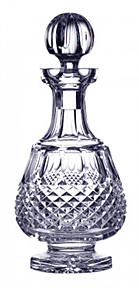 Closely
related to this work is a repair possible with decanters. Sometimes a
stopper of the same type and period as the bottle doesnít fit properly.
If itís too large, the repair is relatively simple. A restorer can grind
the base of the stopper smoothly and evenly until it fits the neck of
the bottle. Even the opening of the latter can be slightly enlarged by
grinding. If the base of the stopper is too small, a sleeve of glass
must be applied and then ground so that a firm fit may be insured. This
repair is naturally not as successful, because itís always obvious. Closely
related to this work is a repair possible with decanters. Sometimes a
stopper of the same type and period as the bottle doesnít fit properly.
If itís too large, the repair is relatively simple. A restorer can grind
the base of the stopper smoothly and evenly until it fits the neck of
the bottle. Even the opening of the latter can be slightly enlarged by
grinding. If the base of the stopper is too small, a sleeve of glass
must be applied and then ground so that a firm fit may be insured. This
repair is naturally not as successful, because itís always obvious.
For those collectors trying to replace a decanterís stopper, itís
important to match it to the tint of the decanter. In the case of Irish
glass, thereís a difference in the tint of decanters made in Waterford
and those made in Cork. Those from the former have a slightly smoky,
bluish tint while those from the later a straw or amber tone. These fine
differences in tone are only apparent to the average observer by close
comparison, but if a stopper from Cork were to be fitted to a decanter
that originated in Waterford, this slight difference in tint would
immediately be emphasized and the original purpose defeated..
Grinding and Polishing Old Glass
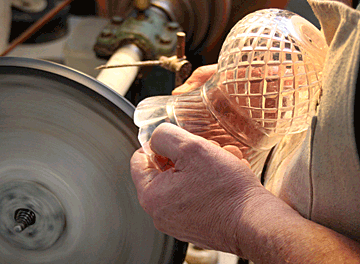 In
grinding and polishing glass to remove slight chips and nicks, a
collector should be sure that the piece so treated should be rare and
fine enough to warrant the expense of restoration. Thereís also the
chance that the piece may break or crack in the process. For example, a
Stiegel-type sugar bowl has a very slight chip on the finial of the
cover. Should the owner take the risk of the cover breaking during the
restoration process or should he or she leave it alone? The chances of
the cover coming through in perfect condition with blemish completely
smoothed away are 99 out of 100. But thereís always the chance that even
in the hands of a skilled glass grinder that it will break. In
grinding and polishing glass to remove slight chips and nicks, a
collector should be sure that the piece so treated should be rare and
fine enough to warrant the expense of restoration. Thereís also the
chance that the piece may break or crack in the process. For example, a
Stiegel-type sugar bowl has a very slight chip on the finial of the
cover. Should the owner take the risk of the cover breaking during the
restoration process or should he or she leave it alone? The chances of
the cover coming through in perfect condition with blemish completely
smoothed away are 99 out of 100. But thereís always the chance that even
in the hands of a skilled glass grinder that it will break.
Curing Sick Glass
Sometimes a piece of old glass is quite free from nicks or chips but the
surface has begun to disintegrate, giving a slightly cloudy or frosted
appearance. If it has gone beyond the initial stages, itís an example of
sick glass. There are two causes for sick glass. Either the proportions
of the batch from which the piece was made were incorrect, or the piece
has oxidized from chemical reaction. The latter may have been due to the
glass having been left for years in a damp cellar, having been buried in
the earth, or having been used overlong as a container for some liquid.
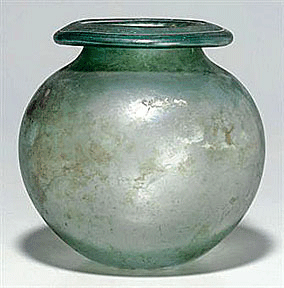 Extreme
examples of sick glass are sometimes very beautiful, such as the
iridescent pieces recovered from Egyptian, Grecian, Roman archaeological
sites. Extreme
examples of sick glass are sometimes very beautiful, such as the
iridescent pieces recovered from Egyptian, Grecian, Roman archaeological
sites.
Unfortunately, in normal pieces of sick glass, thereís seldom any
iridescence, but only a cloudy, frosted tone. In the initial stages,
this condition can be rectified by repolishing, provided the restorer
can reach both sides of the piece to clear the damaging cloudiness.
Plates, bowls, drinking glasses and similar shaped pieces lend
themselves to this treatment. If the disintegration is only on the
surface and has not permeated the material, such work is usually
permanent. Otherwise, itís of only temporary benefit, and the telltale
cloudiness shortly reappears.
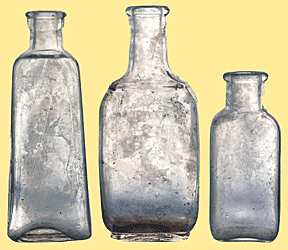 Old
flasks and bottles, with a mild cloudiness, cannot, because of their
shape, be sent to the re-polisher, since he has no means of reaching the
inner surface of the glass with his bluffing and polishing wheels. On
the other hand, some collectors have developed an ingenious technique
for treating bottles so afflicted, and it is reasonably successful. They
take a pliable green twig, and attach a swab to one end, then dip it in
a good grade of clear, colorless mineral oil and patiently work it
around inside of the bottle. They rub each cloudy spot until it
disappears under the action of the oil. After treating the bottle or
flask, they tightly cork it. If the owner of the piece removes the cork
for any reason, the cloudiness will return as soon as the oil has
evaporated. Old
flasks and bottles, with a mild cloudiness, cannot, because of their
shape, be sent to the re-polisher, since he has no means of reaching the
inner surface of the glass with his bluffing and polishing wheels. On
the other hand, some collectors have developed an ingenious technique
for treating bottles so afflicted, and it is reasonably successful. They
take a pliable green twig, and attach a swab to one end, then dip it in
a good grade of clear, colorless mineral oil and patiently work it
around inside of the bottle. They rub each cloudy spot until it
disappears under the action of the oil. After treating the bottle or
flask, they tightly cork it. If the owner of the piece removes the cork
for any reason, the cloudiness will return as soon as the oil has
evaporated.
This treatment is, of course, not a cure. Sometimes, the oil finally
gives the glass a slightly yellow cast. Bottle collectors often find
dried sediment in their bottles. If they canít remove the sediment with
liberal doses of good soap and water, they can fill the bottle with
either a mild acid or alkaline solution, and let it stand for a day or
two. It may be necessary to use first one and then the other. If the
sediment is acidic, the alkaline solution will produce a chemical
reaction that will loosen it. If the substance is alkaline, the acid
solution will have the desired effect. In no case should a powerful
reagent be used. Vinegar and washing soda, both inexpensive and mild,
are excellent mild reagents.
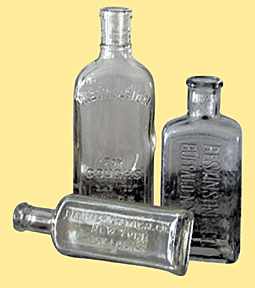 Dealing
with Dried Sediment Dealing
with Dried Sediment
If sediment still remains, a collector can fill the bottle about a
quarter full of clear water and add about two tablespoons of fine steel
shot, followed by corking the bottle and shaking it thoroughly. This
scours the inside effectively. If shot isnít available, clean bird
gravel used with less water can be substituted. Itís important not to
use lead shot since itís not sharp enough to be effective, and if
thereís any trace of chemical in the bottle, the result may be a coating
of lead solution. This isnít only difficult to remove but, in extreme
cases, can ruin the bottle or flask.
To read
more of my articles, please
visit
my Web site.
<
Back to Caring for Your Collections
Archives
Next Article >
|
